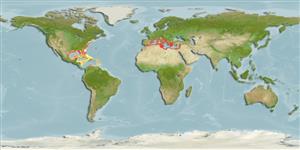Common names from other countries
Environment: milieu / climate zone / depth range / distribution range
Ecología
; rango de profundidad 1 - 838 m (Ref. 83435). Subtropical; 60°N - 12°N, 95°E - 65°E (Ref. 83435)
Distribución
Países | Áreas FAO | Ecosistemas | Ocurrencias, apariciones | Introducciones
Atlantic Ocean and the Mediterranean Sea.
Length at first maturity / Tamaño / Peso / Age
Maturity: Lm ? range ? - ? cm Max length : 5.0 cm DL macho / no sexado; (Ref. 83435)
Life cycle and mating behavior
Madurez | Reproducción | Puesta | Huevos | Fecundidad | Larva
Members of the order Neotaenioglossa are mostly gonochoric and broadcast spawners. Life cycle: Embryos develop into planktonic trocophore larvae and later into juvenile veligers before becoming fully grown adults.
Templado, J. and R. Villanueva. 2010. (Ref. 85339)
IUCN Red List Status (Ref. 130435)
CITES status (Ref. 108899)
Not Evaluated
Not Evaluated
Human uses
| FishSource |
Herramientas
Más información
Age/Size
Crecimiento
Length-weight
Length-length
Morfología
Larva
Abundancia
Fuentes de Internet
Estimates based on models
Preferred temperature
(Ref.
115969): 13.2 - 15.9, mean 14.2 (based on 171 cells).
Price category
Unknown.
